TREE LIFE 518
OCTOBER 2023
Greetings all, this is the second Tree Life in a very short period so we can catch up and be able to hand over to the new editor with a clean slate – no more catching up necessary! In terms of tree outings, one thing to remember is that we have the first outing of every month on the first Saturday morning at 08:30 am at the National Botanical Garden which continues to fascinate us as with the under-storey bush growth being cleared, more areas are becoming accessible and we are finding more and more new or unidentified trees. The other outing of the month (except December when there is no outing) is either on a Saturday afternoon somewhere nearby or on a Sunday morning further out – of course, this is not set in stone as occasionally this changes for some good reason.
Regarding the afternoon tree outing to the Bridgeways Complex Tree Outing on 22nd July, two issues have come up:
- The mystery acacia is no longer a mystery – it was identified by Mark Hyde and confirmed by Jonathan Timberlake (who used to work at Kew but is now retired) as an Acacia nilotica subsp. indica. The indigenous one we are used to is Acacia nilotica subsp. kraussiana.
- I wrote: Dovyalis caffra trees that Ann had obtained mostly from the Bulawayo area – Not true. Here is the true story. Ann got seed from Kirstenbosch because as a member of the Botanical Society, she was entitled to get 15 free packets of seed a year. She planted a Dovyalis hedge on the farm in Norton which produced a lot of fruit which she used to make an excellent jelly. A lot of seedlings grew under the hedge and it’s these she used to plant at Bridgeways.
Temp Ed – Tony Alegria
NATIONAL BOTANICAL GARDEN OUTING 3rd SEPTEMBER 2023
By Tony Alegria
Saturday morning began as a cool sunny day but it warmed up to become uncomfortable warm/hot! Only six of us turned up for the tree walk with two ladies present namely Meg Coates Palgrave and Dawn Siemers, the guys were Jan van Bel, Jim Dryburgh, Mark Hyde and myself. Later we were joined by Mary Toet and her helper who also left early. The mission for the day was to find trees in flower and anything else that caught the eye.
The first tree we looked at was the Eucalyptus torelliana (new name: Corymbia torelliana) which like most gum trees comes from Australia and neighbouring islands. What’s amazing about this tree is that it seems to flower virtually all year round and looks more tree-shaped than the normal very tall gum trees you see around Harare. Like most gum trees, the flowers have no petals, mainly lots of stamens and the fruit is a nice-looking barrel.
We then looked at the Baikiaea plurijuga which were not flowering but one of them appears to have died and in that clump of trees, where it was, is a Prunus cerasoides. Flowering cherry and a Guibourtia coleosperma. Large false mopane which we hadn’t noticed before. With the clearing of the undergrowth still in progress more and more trees are coming to light.
We came across a fig tree which had many figs and of course, we all know that figs have flowers on the inside thus the tree was full of flowers! The tree was labelled with a number which indicated that it was a Ficus glumosa. African rock fig but the guru thought that was incorrect. Well, Meg was right, it turned out to be a Ficus stuhlmannii. Lowveld fig. The figs have pointy ends with the ostiole somewhat inside.
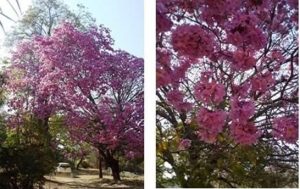
Tabebuia heterophylla Photo by Tony Alegria
We did see a few trees with flowers although admittedly not many:
Eucalyptus torelliana; Combretum hereroense. Mouse-eared combretum; Erythrina lysistemon. Sacred coral-tree; Albizia anthelmintica. Worm-cure albizia; Senna singueana. Winter senna and a stunning-looking big tree which was covered with pink flowers – Tabebuia heterophylla. Pink trumpet tree.
The Brachystegia spiciformis. Msasa had many flower spikes but with very few flowers now open – these flowers have a really gorgeous perfume. The Cassia abbreviata. Long-tail cassia was full of flower buds with the first lot of flowers to open anytime soon – really soon!
TREE OUTING TO UMWINSIDALE SUNDAY 20th AUGUST 2023
By Tony Alegria
Sunday morning was a bright, sunny, fairly hot day when we went to the home of Sonja Messick, just off the Umwinsidale Road for a tree outing. Her house is built on the side of a rather steep slope and the view from her lounge was spectacular. This is a miombo woodland area and the trees just below her house dropped rapidly into a sea of green with many trees in new leaf showing up reddish colours. There were fifteen of us including a few local residents present to enjoy the sight and the walk.
I was informed by the local residents that going downhill wasn’t going to give us any more trees than just walking along the road. Bearing in mind the average age of the group, I thought it would be a lot better for us just to walk along the road and see what was there. The miombo woodland where we were consisted mainly of Brachystegia spiciformis. Msasas and Julbernardia globiflora. Munondos which we talked about then we started looking at other trees. The first one to catch my eye was a Pittosporum viridiflorum of which we saw many small trees however there were a few bigger ones near the main road.
There were many Uapaca kirkiana, none of them very big and in fact on the side of the hill there were no really big trees of any sort. Surprisingly there were quite a few Faurea rochetianas, the smaller ones had bigger leaves and it was very easy to see the inter-marginal vein that linked all the side veins. Also unexpectedly there were some Dodonea viscosa. Sand olives.
We only saw one fig tree which only had very young red leaves Ficus ingens. Red-leaved fig.
We came across only one albizia and that was one I had never seen before around Harare and that was an Albizia harveyi. Some of the other trees seen but not mentioned above: Searsia longipes; Vangueriopsis lanciflora; one small Toona ciliata; Turraea nilotica. Miombo honeysuckle tree; Lannea discolor. Livelong; Pseudolachnostylis maprouneifolia. Duiker berry; Syzygium guineense. Woodland waterberry; Gymnosporia senegalensis. Confetti tree; Ekebergia benguelensis. Woodland dogplum; Ochna schweinfurthiana. Brick-red ochna; Ligustrum lucidum. Privet; Ziziphus mucronata. Buffalo-thorn; Strychnos spinosa. Spiny monkey-orange and Parinari curatellifolia. Mbola plum.
Only a few of us actually reached the Umwinisdale Road and we then turned back for tea and buns very kindly supplied by Sonja. However, when I reached the residence I was taken by Sonja to show me some trees she had planted and others around the house. Here I saw a small litchi and an avocado pear tree. But there were also two Acacia trees – Acacia sieberiana and A. polyacantha. Next to the driveway was a Psorospermum febrifugum. Christmas berry and across the road the only Dichrostachys cinerea. Chinese lantern I saw.
THE SCREW PINE, AN ECOLOGICAL SUCCESS (Article 3)
By Mary Toet
This is a further article, a successor to my two previous articles in Tree Life about the Screw pine.
Introduction
Screw pines date back to the Jurassic period. They belong to the family Pandanaceae and the genus Pandanus, of which there are 580 currently accepted species. This large number shows that there is a lot of variation in the pandans.
They are found naturally where there are monsoon rains. Monsoon rains help provide fresh water that does not contain sodium chloride molecules.
Rainwater is fresh water (“FW”). Water evaporates from the sea surface and condenses to form clouds. Rain depends on the temperature of the sea surface. Temperatures change and the largest supply of FW comes with the monsoons.
The Screw pine roots survive in a salty medium, but they need FW. FW is important to form the apical meristem and the cells and develop the regions of development and elongation.
Organisms living in a salty environment are referred to as psammophiles. The Screw pine is an ecological success because it can adapt to changes of salinity and FW availability in its surroundings.
Impact of root damage
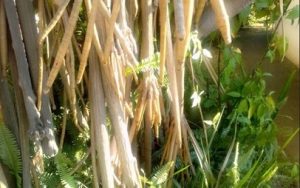
Figure 1: regrowth of damaged roots
Observations at Dandaro, Harare of a screw pine where the adventitious roots had been hacked, show that two out of the four damaged roots produced a viable root which grew rapidly into the soil. Six weeks later numerous prop roots developed.
Furthermore, growth from the meristem will extend the root upwards as well as downwards. When these new roots touch the overhanging branch, they will combine with the branch. This multiplication of roots makes the screw pine useful in stabilizing sand dunes.
If the ecology of the protection given by plants is destroyed by man, there can be serious flooding as happened in Galveston, USA, where beaches were destroyed by storm water surges and businesses and homes were flooded.
Pollination
There are a variety of pollination methods. Pollen from flowers that are large and evident attract bees, birds, bats, and mice. The wind also aids pollination in some Pandanus species. The male gamete from the anther produces a pollen tube that carries the male gamete which fuses with the female ovule. Conditions may not always be favourable for fertilisation considering monsoon rains, spring tides and currents in the tidal zone.
The nut (seed) is very attractive having orange, red, yellow and black colouration and contains sugar.
The fruit containing the fertilized seed is dispersed by humans who have various uses for it as well as monkeys, birds and rats. The fruit is eaten by mammals including Indian elephants and the seed is discharged in the faeces.
Only one set of fruit is allowed to develop. Other fruit with the ability to form fruit is prevented as they are starved of food and water. They go black, shrivel and fall from the tree. It is possible that the mechanism for the black dead fruit falling might be by forming an abscission layer.
Fruit and seed dispersal
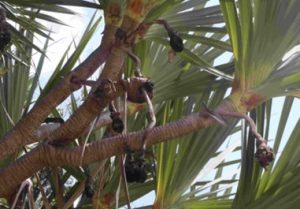
Figure 2 Fruiting bodies which did not develop, Dandaro. Photo Mark Hyde
The fruit has to be dispersed for a good chance of survival; otherwise germinating seeds would compete with the parent Screw pine.
The movement of a viable seed can take from three months or as long as two years. When the seed has sufficient water free of salt it will germinate. Though slow this allows for a wider dispersal and ecological success.
The number of ovules that can form seed are 50 or more, and produced inside the fruit of a female cone can be 7 or more; each fruit may have 7 ovules The female cone is composite and can have 50 or more fruits. These numbers enhance the chances of successful survival.
The seed will only germinate and develop at a constant of 20 C to 27 C. The genus Pandanus has spread across three Oceans, the Atlantic, Pacific and Indian Oceans.
Economic significance
The genus Pandanus is beneficial to Man and is second only to the coconut in economic importance in Japan and the Far East. The many uses made by Man make it economically viable for the cultivation of seed, done by horticulture and nurseries. By these means, the growers of Pandanus and producers of Pandanus seed keep the genus alive. They also contribute significantly to understanding the biology of the Screw pine.
Mitosis making root growth possible does not involve genetic change. Branches of screw pine broken off by storms take root and are predominantly male. Commercial seed banks are a sure method of keeping seed.
Easter Island palm
There is an interface between Man and palm. An interesting lesson can be learnt from Easter Island. The island is now called Rapa nui, it lies 3,700 km from the mainland of South America. On the island was a species of palm, now extinct, the Rapa nui palm, Paschalococcus disperta.
On Easter Island, the sailors brought rats on their ships and there were no natural predators. The seed of an Easter Island Palm can take 50 years to germinate. They were doomed to extinction.
Unlike the Easter Island Palms, the Pandans are not endangered because of their unique versatility, namely their ability to colonise sand banks and survive spring tides, wind, and salt and be dispersed by the sea. They have economic importance to man, and this also ensures their survival.
All that remains of the Easter Island Palms are wooden statues.
The Pandans survive time and tide.
A TRIP TO THE GREAT DYKE, 11-14 JULY 2023, PART 2
Text and photos by Ian Riddell
Day 2: 12th July
We started out from Mvurwi in the dark again in order to scout out a fixed observation point for today’s bird observations on the Great Dyke. Turning east off the track we followed a well-used and dusty road into a surface-mined area and headed through it to a serpentine hill that looked suitable.
Walking to the top we had a view to the east and south over farms in the granite belt. Pools of cloud in depressions looked like lakes. The freezing wind whistled through the grass and I was slightly more prepared today with a pair of gloves; I only briefly took them off to use the phone or camera.
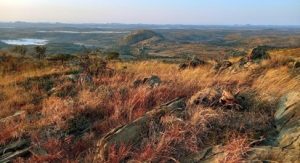
A cold morning view
Let’s just say that the birds had no intention of venturing out, unlike these crazy humans, so there was plenty of time to botanise to while away the hours. An African Harrier-hawk flew below at 07h53 and Cattle Egrets were down in the fields with livestock. A Lanner Falcon at 09h10 was exciting and a White-necked Raven or two added to the barely moving bird list.
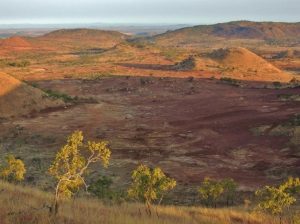
Surface stripping for Chrome. Proteas on the westward flank of the hill.
There tended to be more trees on the west of these hills; Cluster-head proteas Protea welwitschii around us and Rubber trees Diplorhynchus condylocarpon further downslope. It was a relief to slip over the brow of the hill and search for plants where it was sheltered and significantly warmer, otherwise we had to hunker behind as large a rock as possible for protection. A Velvet-leaf Tapiphyllum velutinum on the windward side was sculpted by the constant prevailing winds, leaning upslope in resignation.
But these were not nearly as exciting as the endemics that were common in the rocky habitat here – the Dyke Aloe Aloe ortholopha, the cushion-forming Euphorbia acervata and Euphorbia memoralis, all Vulnerable on the Red Data list.
A feature of the Dyke Aloe is the horizontal racemes, somewhat reminiscent of marlothii in South Africa.
Euphorbia memoralis doesn’t feature on the Flora of Zimbabwe website and Mark intends to add it at some stage.

Dyke Aloe Aloe ortholopha, Euphorbia acervata and Euphorbia memoralis
Euphorbia monteiri occurs on the serpentine as a Zimbabwe Red Data List species but doesn’t feature on the website either. I didn’t find it here and it is one to look for in future, once I sort out how to separate it from memoralis. It is more widespread in central and southern Africa. We did find a lot of the endemic Wild’s euphorbia Euphorbia wildii; it was certainly locally common but all were small compared to the 3 m height that they can attain. Both monteiri and wildii have similar-looking tuberculate stems.
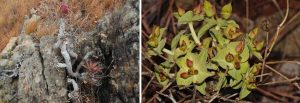
Wild’s euphorbia Euphorbia wildii
Blepharis subvolubilis was a common herb, with some on the hill and many in the little valley at the base where it was the dominant plant. These Acanthaceae grew in low domes and the majority had white flowers. The Kalanchoe sp. needs identifying but the pretty pink flower shining amongst the rocks was Galpin’s Firelily Cyrtanthus galpinii, a herb in the Amaryllidaceae.
After we had finished our watch we went to check for bats in what looked like an adit overlooking the mined area. But the square shadow we saw from a distance was formed by an old rectangular trench cut into the hillside. The large shrubs growing there were another endemic to the serpentine of the Great Dyke, Jamesbrittenia fodina, often associated with disturbed soils.
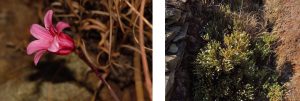
Cyrtanthus galpinii on the hill and Jamesbrittenia fodina colonising a prospecting trench
We drove back to the northern section and up the rough track that climbed the ridge, following it south to see where it went. It took us almost to the met mast, where by chance we met the others. This was the end of the illegal woodcutters’ track and we had passed a small truck up in the miombo doing their business! This miombo wood cutting will have negative impacts if left uncontrolled.
Our turnaround point took some manoeuvring amongst the rocks and trees but a nice discovery was Rhynchosia monophylla, a new record for the northern division.
Retracing our route, we came to the start of the spur where we had our O.P. yesterday so we parked and walked through the short miombo on the pyroxenite ridge. This allowed us to sample this section and do a walking transect. We were fortunate to come across a bird party that produced miombo specials like Red-faced Crombec, Cabanis’s Bunting, Spotted Creeper, Green-capped Eremomela, Grey Penduline-tit, Southern Hyliota and others, though trying to follow birds in a canopy that’s not much higher than you is not easy. My South African friend was happily notching up the lifers in a habitat he hadn’t experienced before!
East of the north O.P. we checked out the east edge of the Dyke to see if that was a better O.P. but decided it would take too long to get to for a first-thing-in-the-morning survey and the rocky ground was a real ankle-twister! We sat down for a static survey, anyway, with a view over the farmlands below but only heard Cape Turtle-dove and Blackheaded Oriole. The botanising was naturally more productive.
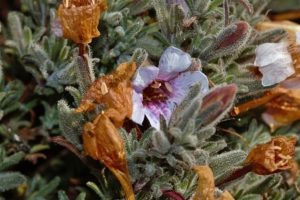
A Sickle-leaf protea Protea petiolaris grew there with lots of little babies skirting it. There was an area of short rhizomatous
Ochna, species unknown, and clumps of Dyschoriste trichocalyx subsp. verticillaris (left). A short Munondo Julbernardia globiflora had lots of interesting galls and ants attending wax scale insects.
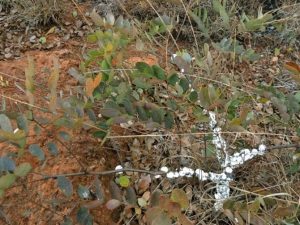 After our lunch and headed back to the centre of the ridge and onwards to the north. Luckily we found a baboon trail, which made walking much easier as there were fewer rocks. A section of the path had an amazing infestation of large wax scale, particularly on a small Purple-leaved-Albizia Albizia antunesiana.
After our lunch and headed back to the centre of the ridge and onwards to the north. Luckily we found a baboon trail, which made walking much easier as there were fewer rocks. A section of the path had an amazing infestation of large wax scale, particularly on a small Purple-leaved-Albizia Albizia antunesiana.
Further on we arrived opposite our O.P. where there were some Miombo Rockthrushes and Familiar Chats, and then a bit further on was a slender Cussonia spicata. Eventually, we got to the north edge of the Dyke overlooking the Suoguru Gap, having encountered a lot of bird activity without seeing what they all were!
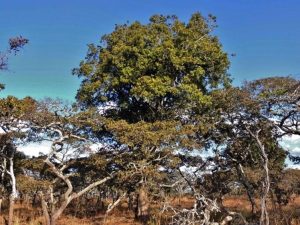 On our return to came across the mystery trees, the two or three distant skyline bumps we saw towering over the canopy from our O.P. yesterday. They were Syzygium, presumably Syzygium guineense. This was most intriguing and these anomalies, in the shallow rocky soils here, had their own microhabitats beneath. In their shade grew taller and possibly different grasses and Bracken Pteridium aquilinum subsp. capense. Under one was Carex sp. sedges. I deliberated whether there was an underground water source here but that somehow doesn’t seem likely.
On our return to came across the mystery trees, the two or three distant skyline bumps we saw towering over the canopy from our O.P. yesterday. They were Syzygium, presumably Syzygium guineense. This was most intriguing and these anomalies, in the shallow rocky soils here, had their own microhabitats beneath. In their shade grew taller and possibly different grasses and Bracken Pteridium aquilinum subsp. capense. Under one was Carex sp. sedges. I deliberated whether there was an underground water source here but that somehow doesn’t seem likely.
We couldn’t quite find our baboon trail on the way back and did a fair bit of ankle twisting zigzagging through the woodland hoping to find it.
Back at the truck, I noticed quite a few Fadogia homblei in the grasses. They were past their prime at this time of the year but distinctive with their golden-green leaves in whorls of 4.
To be continued
Tree Society Committee and Contacts
Chairman Tony Alegria tonyalegria47@gmail.com 0772 438 697
Honorary Treasurer Bill Clarke wrc@mweb.co.zw 0772 252 720
Projects Jan van Bel jan_vanbel@yahoo.com 0772 440 287
Venue Organiser Ann Sinclair jimandannsincs@zol.co.zw 0772 433 125
Committee Member Ryan Truscott ryan.kerr.truscott@gmail.com 0772 354 144
Secretary Teig Howson teig.howson@gmail.com 0772 256 364
Tree Society Website https://treesociety.org.zw/
Tree Society Facebook https://www.facebook.com/groups/ztreesociety/
Flora of Zimbabwe: https://www.zimbabweflora.co.zw/
Flora of Tropical Africa: https://plants.jstor.org/collection/FLOTA



